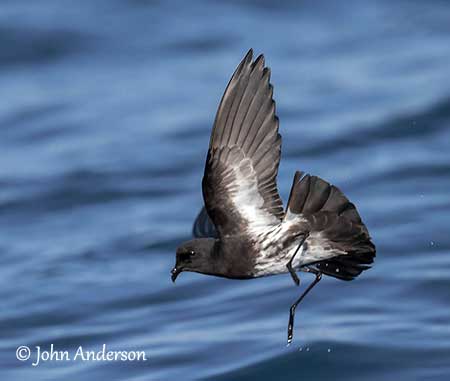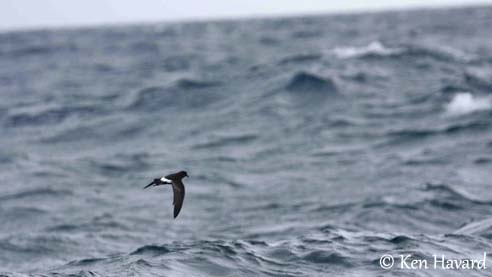
Fr: Océanite de Nouvelle Zélande
Ang: New Zealand Storm Petrel
All: Neuseeländische Sturmschwalbe
Esp: Paíño Maorí
Ita: Uccello delle tempeste di Nuova Zelanda
Nd: Nieuw-Zeelands Stormvogeltje
Sd: Maoristormsvala
Photographers:
John Anderson
John Anderson Photo Galleries
Ken Havard
My Bird Gallery & Flickr gallery 1 & Flickr gallery 2
Alan & Ann Tate
AA Bird Photography
Text by Nicole Bouglouan
Sources :
HANDBOOK OF THE BIRDS OF THE WORLD vol 1 by Josep del Hoyo-Andrew Elliot-Jordi Sargatal - Lynx Edicions - ISBN: 8487334105
BirdLife International (BirdLife International)
New Zealand birds and birding (Narena Olliver)
Wikipedia, the free encyclopaedia
Te Ara – The Encyclopedia of New Zealand
DESCRIPTION OF THE BIRD:
Biometrics:
Length: 17-18 cm
Weight: 35 g
The adult has black-and-white plumage and is sparrow-sized.
On the upperparts, head, neck, mantle, back, wings and tail are blackish-brown. Rump and uppertail-coverts are well-defined and white. We can see an indistinct pale wingbar on the inner upperwing.
On the underparts, chin, throat and breast are blackish-brown. Belly and vent are white, with variable amount of dark streaks along the flanks and across the belly, but less distinct in the central area. On the underwing, there is a pale wingbar, a white central panel, formed by the white median and greater underwing-coverts. We can see a broad blackish leading edge too.
The head is blackish-brown. The eyes are dark brown. Bill, legs and feet are black.
Both sexes are similar. The juvenile is not described, but it probably resembles adults. The chick is covered with greyish-white down and has blackish bill, eyes, legs and feet.
The genus Fregetta belongs to the subfamily Oceanitinae in the family Hydrobatidae. These birds have relatively short, rounded wings, square tail and long legs which often project beyond the tail during the flight.

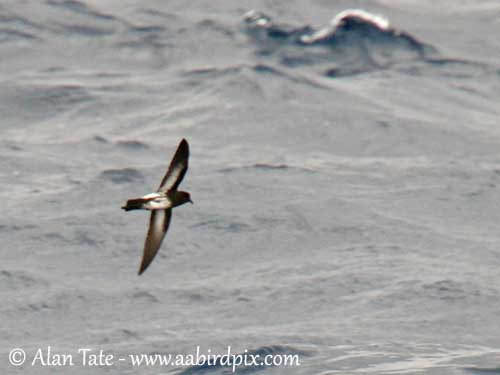
RANGE:
The New Zealand Storm Petrel breeds on Little Barrier Island, on Te Hauturu-o-Toi.
Outside the breeding season, it is found at sea. They have been seen in northern New Zealand waters.
HABITAT:
The New Zealand Storm Petrel nests in burrows excavated in crumbly soil under tall trees in inland forest on Little Barrier Island.
The New Zealand Storm Petrel is usually seen alone at sea, but small groups of 10-20 birds can be seen around good food sources.
On calm days without wind, it often sits with other seabirds such as Buller’s Shearwater and Cook’s Petrel.
The breeding behaviour of the New Zealand Storm Petrel is poorly known, as the nests were discovered in February 2013. They breed in colonies under tall forests.
Usually, petrels perform aerial displays above their nesting areas. The birds of a pair follow each other while calling loudly.
Most of the sexual activities take place inside the burrow, in the nest chamber. Both mates perform mutual preening and bill-touching.
But more information is needed.
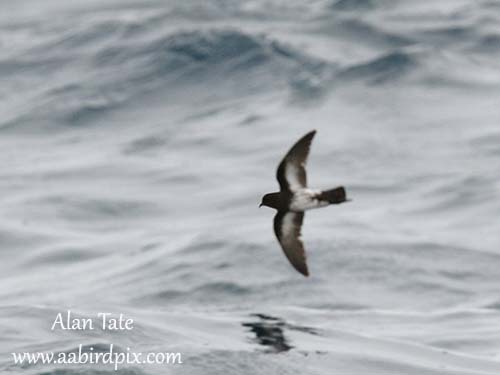
REPRODUCTION OF THIS SPECIES:
The breeding season starts in late November with the egg-laying, and the juveniles leave the breeding grounds in late May/June.
The New Zealand Storm Petrel nests in burrow similar to a crevice, excavated in crumbly or rocky soil, or in leaf-litter on the forest-floor. Like other petrels, this species has probably nocturnal habits to avoid predation.
The female lays a single pinkish-white egg with some small slightly darker spots. The incubation by both adults lasts more than one month.
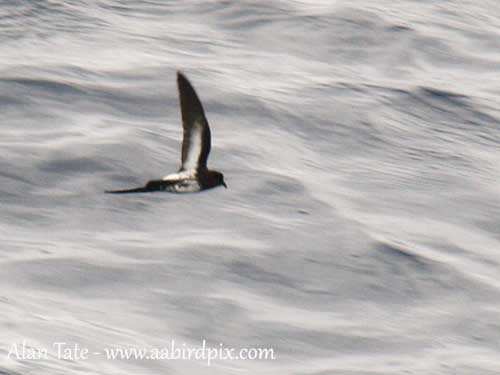
PROTECTION / THREATS / STATUS:
The New Zealand Storm Petrel currently occurs on Little Barrier Island which is free of predators, following cat and rat eradication in 1980 and 2004. The species will increase the numbers as long as the area will be maintained predator-free.
The population is very small with about 50 birds, based on the small number of records since 2003. However, flocks of 10, 20, 30 birds have been recorded, suggesting a larger population.
The New Zealand Storm Petrel is currently listed as Critically Endangered. In New Zealand, this species is considered as Nationally Endangered.
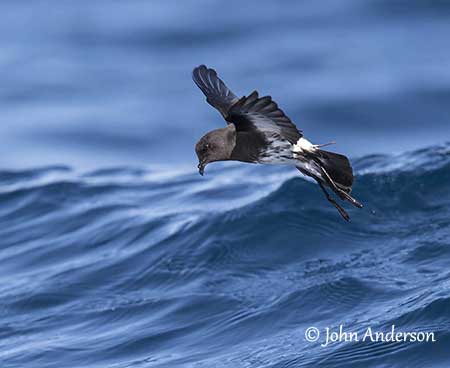
The New Zealand Storm Petrel is probably migratory. Moulting birds seen off Australia (Queensland, New South Wales and Victoria) indicate some post-breeding movements across the Tasman Sea and N to the Coral Sea. In addition, the absence of this species from Hauraki Gulf between June and September every year, confirms this migratory behaviour.
The New Zealand Storm Petrel has direct flight and performs rapid changes in direction. It usually flies low over water and stop over the surface with dangling legs and outspread wings to maintain the balance in the air.
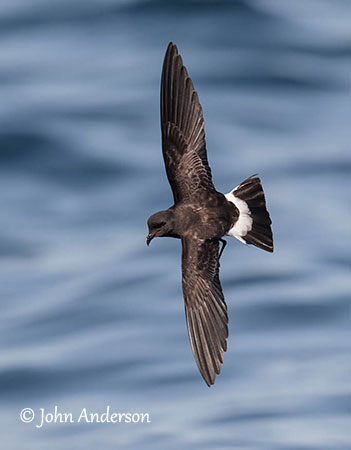
CALLS AND SONGS:
The voice of the New Zealand Storm Petrel is not currently recorded. However, petrels are usually silent at sea, but they can produce repeated peeping and chattering sounds when they are competing for food. They are more vocal at the colony at night.
BEHAVIOUR IN THE WILD:
The New Zealand Storm Petrel probably feeds on small crustaceans and plankton. This information was confirmed by the observation of captive birds regurgitating food items including crustaceans.
It feeds by dipping, surface-seizing and on wing by pattering with dangling legs. It may occasionally perform shallow plunges from the air. It flies low over the water. The prey is caught with the bill while only the head touches the water.
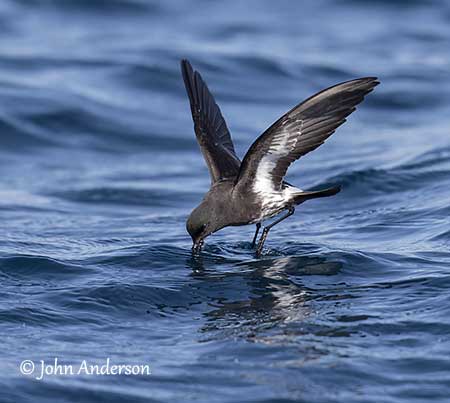
New Zealand Storm Petrel
Fregetta maoriana
Procellariiformes Order – Oceanitidae Family
INTRODUCTION:
The New Zealand Storm Petrel was considered as extinct species since 1850, but several observations from 2003 to the present confirm the existence of an unknown colony of less than 50 individuals and mature individuals. This colony has been discovered on Little Barrier Island in February 2013. There, the birds are nesting in burrows under the tall forest.
The New Zealand Storm Petrel is marine and pelagic, and comes to land only for breeding. It is endemic to New Zealand.
